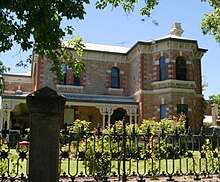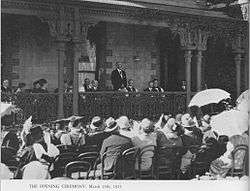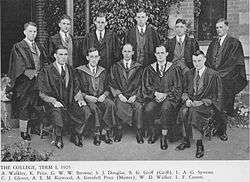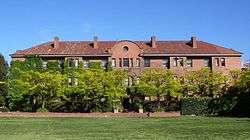St. Mark's College (University of Adelaide)
| St Mark's College | ||||
|---|---|---|---|---|
| The University of Adelaide | ||||
 The college as seen from Pennington Terrace | ||||
|
| ||||
| Location | North Adelaide | |||
| Motto | Spernit Virtus Humum[1] (Latin) | |||
| Motto in English | Excellence Reaches for the Stars (lit. Excellence spurns the dry earth) | |||
| Established | 1925 | |||
| Named for | Mark the Evangelist | |||
| Gender | Co-educational since 1982, formerly all-male | |||
| Master | Rose Alwyn | |||
| President | Benjamin Massey | |||
| Residents | 245 | |||
| Website | stmarkscollege.com.au | |||
St Mark's College is a co-residential college in North Adelaide, South Australia. Founded in 1925,[2] it is affiliated with the Anglican Church of Australia, yet accepts individuals from all faiths. It is the oldest residential college associated with the University of Adelaide and also accepts students attending the University of South Australia and Flinders University.[1][3] Located next to St Peter's Cathedral on Pennington Terrace, the College houses 245 tertiary students in both dormitory and apartment accommodation.
In 2018, multiple media networks reported allegations of hazing, involving sexual misconduct, at the College. In response, the College launched an internal investigation.[4] In May 2018, it was reported that one claim - that a woman was forced to take their top off in front of other students - could not be substantiated by the internal investigation, and was referred by the College to police for further investigation.[5]
History
Foundation and opening
The foundation of St Mark's College was driven by the demand for student accommodation, which the University of Adelaide did not provide at the time. The founders of the University believed that learning thrives best on 'haggis in a hovel', and that consequently there was no necessity for the provision of residence or its official control. It was thought that students should receive no tutorial assistance but rather sink or swim on a few lectures from their professors each week. The Reverend Julian Bickersteth led the drive to establish a residential college, with the Anglican Synod of the Diocese of Adelaide appointing a committee to that end in September 1920.[6]

Early in December 1921, a meeting of the provisional committee was held at St Peter's College. Negotiation for a site for the college began in 1922. By the end of the year, H. W. Hodgetts secured options to purchase, for about £10,000, the historic residence of the late Sir John Downer at Pennington Terrace, North Adelaide, together with the adjoining land on Kermode Street, a horse paddock and some old cottages. This, with the subsequent purchase of neighbouring houses and land, gave room for a college of up to 150 students. While the proposed constitution fully safeguarded the Anglican character of the institution, it admitted a number of non-Anglicans to the council and opened the college freely to men of all faiths.
Progress was very slow during 1923 and 1924. The funds which had purchased the property would not also suffice to open the college. Realising that the small funds available prohibited any building, the council instructed the architect, Walter Bagot, to adapt the Downer House to accommodate a single, or temporarily detached married Master; twelve tutors and students; a cook-housekeeper garlanded with the title of Matron, and two or three maids. In December the committee considered some forty Australian and New Zealand applications for the Mastership, together with some forty English names forwarded to them by Sir Francis Wylie of the Rhodes Trust. They announced the Mastership of St Mark's was to be Sir Archibald Grenfell Price on 17 December.

The name of the college was the subject of some debate. Initially it was to be called Christ's College, but a movement soon developed for the name to be changed to King's. A compromise was reached to name the college St Mark's, after the Saint on whose day the ANZAC landing at Gallipoli took place. The University Council approved the affiliation of St Mark's, the first college of the University, on 31 October 1924.
A most interesting decision was the compromise on alcoholic liquors. The founders wished the College to avoid the occasional drinking orgies which they had seen in Oxford and Cambridge, and asked the Bishop to support a compromise which would make the College damp rather than either wet or dry. Under this arrangement the Council would grant the students access to beer and light wines in regulated quantities, but spirits were rigidly excluded.
Early in March 1925, the first council was elected, a few days before the College opened. By 25 March the founders had entries from a resident tutor, A. E. M. Kirwood, M.A., a University Lecturer in English and a man of very fine character, and nine students, L. A. G. Symons, A. Walkley, Kells Price, S. J. Douglas, B. Griff, L. F. Casson, W. D. Walker, B.Sc., C. J. Glover and G. W. W. Browne. The college was opened by the Governor, Lieutenant-General Sir Tom Bridges, and blessed by Bishop Nutter Thomas.[7] The College Coat of Arms and colours also date from the first year.
Establishment
During the initial years accommodation and equipment were severely lacking due to shortage of funds and labour costs being extremely high before the depression. This brought on a continuous growth policy by piecemeal extensions, where the purchase of land and development of buildings was initiated when the college could afford it. The first stage of "New Wing" (Newland Building) was opened in 1926, and a second in 1927.
From the outset the Council placed a great emphasis on building up a resident and non-resident tutorial system; this emphasis has created a framework which is still in practice today. Scholarships and bursaries were also initiated early on to aid clever or needy students. The college also developed its societies and sporting culture early on. As early as 1928 a college "Wranglers' Club" was established to conduct debates and entertain distinguished guests. The College, as well as competing in the University games and societies of the time, also held internal games and sports as Intra-College sport did not exist. In 1934, St Mark's hosted the first inter-collegiate football match in South Australia, defeating Trinity College, Melbourne.
In 1939 the College seemed set for a period of steady if unspectacular advance in service to the community and more immediately to the University, when the Second World War intervened and was followed by an almost complete revaluation and reorganization of University life.[8]
War, recovery and growth
In December 1940, the College was leased to the RAAF for the duration of the war. The remaining students were relocated to a lodging house in Kermode Street. During their tenancy, the RAAF made several improvements to the buildings which were subsequently purchased by the college.[6]
Following the conclusion of the war, the college re-opened on 10 March 1946. A steady growth in numbers necessitated the purchase and rental of additional properties. In 1949, "North House" in Kermode Street was purchased, and "Montefiore" (which later became Aquinas College) was rented. The first stage of "Memorial Building", the second of the college's dormitory buildings, was completed in 1952. A new dining hall and library was built in 1961, two cottages on the western boundary (nicknamed Cain and Abel) were purchased in 1962, and couple of row houses on the east were purchased in 1963. An anonymous donation allowed the college to purchase the heritage listed Hawker House in 1970, completing the college's present extent.[6]
1980 – present
Women were first admitted to the college in 1982.[6][9]
St Mark's spent the closing years of the 20th Century moving towards the completion of its strategic building masterplan, aiming to eventually house a maximum of 250 students. In 1984, the Creswell Flats were renovated. In 1988, a computer room was established and in 1989, the "Hawker annexe" was renovated to provide additional accommodation. In 1996, a block of flat-style accommodation was erected on the northwestern corner of the college, named New Cain. The old cottages Cain and Abel were demolished in 2001 to make way for the New Abel extension, which opened in 2002. This complex was extended in 2007 to encompass the Lewis Building, and two new wings named the Mathieson and Wall buildings. In 2004 the Allister McLeod Sports Pavilion, a 24-hour gym, was built on the eastern side of the tennis courts. The final major building works in the college's 2025 masterplan are redevelopments of the ageing buildings in the north-east and western boundaries of the college, for which the college is currently fundraising.[10]
Governance
| Appointed | Retired | Name |
|---|---|---|
| 1925 | 1956 | Sir Archibald Grenfell Price |
| 1957 | 1967 | Robert Brook Lewis |
| 1968 | 1978 | Reverend Malcolm McKenzie |
| 1978 | 1982 | Dr Peter Geoffrey Edwards |
| 1983 | 1990 | Reverend Peter Thomson |
| 1991 | 1999 | Robin Ashwin |
| 2000 | 2007 | Hon Dr John Charles Bannon AO |
| 2008 | Rose Alwyn |
The College has three administrative bodies; they are the Council, the Administration and the College Club Committee. The Council is made up of, among others, members of the Anglican Church, the University of Adelaide, St Peter's College, the Old Collegians' Association and senior resident students. It is concerned with long term strategic planning and financing, and is largely separated from the college community. The Administration is responsible for the everyday running of the College.
The College Club is an entirely separate entity to the College administration. All undergraduate residents of the College are members of the College Club (or "Junior Common Room"). Their committee is elected each year by the students, and is composed entirely of students. The College Club Committee is primarily concerned with organising the many social and sporting events throughout the year, as well as intercollege relations with other college clubs in Adelaide and around Australia.[11]
Campus

First year students (known as freshers) are allocated single rooms in one of the three co-residential dormitory buildings on campus: Newland (3 floors),[12] Memorial (3 floors)[13] and Hawker Annexe (1 floor).[14] Each fresher "floor" is a semi-autonomous social group, looked after by a "Floor Tutor", a senior student who provides pastoral care and support for first-year students. Individual rooms are provided with Internet and phone connections, and there are shared laundry and bathroom facilities on each floor. All rooms and external doors are accessed by individual smart card locks.
More senior students may apply for specific rooms within the dormitory buildings, the much sought-after Hawker House mansion,[15] or one of the many apartments with self-contained kitchen, lounge and bathroom facilities.[16]
- Downer House
- This residence (designed by Rowland Rees for Sir John Downer in 1877[17]) was the first building to be acquired by the college. It now houses college administration, the Junior and Senior Common Rooms, an academic tutor's apartment and computing and printing facilities.[18] A draft of Australia's Constitution was prepared in the building's ballroom in 1897.[19]
- Newland Building
- This was the first of the college's dedicated dormitory accommodation, completed in six stages from 1926 to 1964. The architect Walter Bagot drew inspiration from precedents in Oxford, as it was the first tertiary dormitory in the colony and thus without local architectural influences. It remains unique in Adelaide. Most rooms in Newland building are assigned to freshers.[20]
- Memorial Building
- Also completed in stages, "Memorial" (named for the students who fell in World War II) was intended to include a dining hall and eventually enclose the tennis courts completely, forming an Oxford-style quadrangle. However, the "quadrangle" plan was abandoned with the construction of the new dining hall on the southern edge of the tennis courts.[21]
- Grenfell Price Dining Hall
- The centrally located dining hall was built in 1961 to accommodate growing numbers of students. It has seating for up to 250 people.[22]
- The Ian and Pamela Wall Academic Centre
- The Academic Centre on the ground floor of the East Wing houses some of the College's vast book collection, including the rare book collection. Three Simpson Tutorial Rooms are also available for students and are the location for the College's extensive academic tutorial program.
- Allister McLeod Sports Pavilion
- This modern gym, completed in 2015, is open to all students and access is inclusive within the residency fees. In addition to weight machines and free weights, there are a number of exercise machines, including treadmills, a rowing machine and a stairmaster.[23]
- Tennis Courts
- Bounded by the above four buildings are four grass tennis courts that provide a versatile recreation space in the centre of the College.[23]
- Hawker House
- A Victorian mansion was acquired by the college in 1970 through an anonymous donation, and named for South Australian politician Charles Hawker. It is also available for student accommodation, and is usually populated by senior students.[15] A bungalow-style extension was later added for fresher accommodation, known as Hawker Annexe.[14][24]
- New Cain / New Abel / Matheson / Lewis / Wall
- Awkwardly named for the buildings that were incrementally demolished or enveloped as the new structure grew, these three-bedroom apartments are each equipped with laundry, kitchen and lounge facilities. The newest extension, opened in 2007 and incorporating the Matheson, Lewis and Wall buildings, mirrors Memorial Building to the east. The newest apartments vary in floor plan and are occupied mostly by senior students.[25]
- "The Pond"
- This small quadrangle is the central meeting place of the College. The cruciform pond features a sculpture of St Mark.[26]
- Chapel
- The old Downer property stables were converted to a small chapel in the 1970s by a student at the college.[27]
Hazing rituals
In 2018 news.com.au and Buzzfeed revealed that in 2013 St Mark's College published a booklet for students that described hazing rituals, including first year students participating in various potentially compromising acts.[30] The booklet included a points system in which sex with older students was rewarded and sex with other first years was penalised, as well as the publication of rape-approving poems.[30] The University claimed that it was "in no way associated with the publication of 2013". The college Master stated that "the college... has moved a long way since then".[30]
“When God envisages heaven, he thinks of [our] College. Outside our revered utopia exists fiendish, self loathing d*ckheads of inferior intellect who are thus confined to [other colleges, which are considered] “special” homes for the blind, dumb, deaf and r****ded.” O'Mag, 2013.[30][31]
The ABC, Channel Nine, the Advertiser also reported on allegations of bullying at the college in 2018. They revealed that part of the practises were alleged to include forced nudity and being forcibly made to consume spit covered food (both unsubstantiated).[32][33][5] If you opt-out of contributing to the hazing you are forced to hang a dead fish around your neck, according to one former student.[34] According to the College, they only learned of many of the allegations when they were aired by Channel Nine, despite repeated requests by the College to Channel Nine producers for further information prior to airing of the allegations.[35]
In response, the College announced an internal investigation into alleged hazing during orientation week 2018. On 28 March 2018, the College agreed to new rules with the University of Adelaide whereby any student of the university involved in hazing must be reported to the university.[4]
The internal investigation of the hazing allegations revealed one student played "inappropriate material" on a television screen and two students publicly bared their backsides.[5] The students involved were disciplined by the College. An allegation that a female student was forced to remove their top could not be substantiated during the investigation and was referred by the College to the police for further investigation.[5]
Sport
St Mark's College competes in an inter-college sporting competition against Aquinas College, Flinders University Hall, Lincoln College and St Ann's College for the Douglas Irving Cup (formerly, and still usually referred to as, the High Table Cup). Competition takes place throughout the academic year in the following sports: tennis, swimming, cricket, debating, basketball, Australian Rules Football, soccer, netball, hockey, table tennis, volleyball and athletics.[16]
Sporting competitions held internally include pool and table tennis.[16]
Notable alumni
With an Old Collegian's network of over 3500,[36] St. Mark's College has been the home of many notable members of the community. These include:
- Robin Ashwin,[37] Rhodes Scholar, former Australian ambassador to the USSR and former Master of the College.[38][39]
- John Bannon,[37] Premier of South Australia 1982–1992 and former Master of the College[40]
- Richard Blackburn, Rhodes Scholar, former Chief Justice of the ACT
- BM Debelle QC,[37] Justice of the Supreme Court of South Australia.[41]
- Julian Disney,[37] Rhodes Scholar and founder of the Global Governance Group.[38][42]
- John Finnis,[37] Rhodes Scholar, one of the world's leading authorities on legal philosophy and jurisprudence.[43][44]
- Robert Hill,[37] Chancellor of the University of Adelaide, former Australian Minister for Defence and Ambassador to the United Nations.
- Trevor McDougall AC FRS FAA FInstP FRSN,[37] – physical oceanographer and climate researcher
- Tony McMichael,[37] member of the Intergovernmental Panel on Climate Change, director of the Australian Centre for Epidemiology and Population Health.[45]
- Justice RG Matheson QC,[37] former judge of the Supreme Court of South Australia.[46]
- Chief Justice Robin Rhodes Millhouse QC,[37] Chief Justice of Kiribati, former judge of the Supreme Court of South Australia, former Attorney General for South Australia and first Australian Democrats parliamentarian.[47][48]
- Sally Sara,[37] TV and radio journalist with the Australian Broadcasting Corporation.[49]
- Ivan Shearer,[37] member of the United Nations Human Rights Committee, former Dean of Adelaide and Sydney University Law Schools.[50]
- Mike Smith,[37] former Australian Ambassador for Counter-Terrorism to the United Nations[51]
References
- Jensen E & R (1980), Colonial Architecture in South Australia, Adelaide: Rigby, ISBN 0-7270-1404-8
- Kerr C (1983). Archie, the Biography of Sir Archibald Grenfell Price, Melbourne: Macmillan, ISBN 0-333-35624-1
- La Nauze J A (1972), The making of the Australian constitution, Melbourne: Melbourne University Press, ISBN 0-522-84016-7
- Price, A G (1968). A History of St. Mark's College, University of Adelaide, and the Foundation of the Residential College Movement, Netley: The Council of St. Mark's College
- Walkley, G (1985). St. Mark's College: The Buildings and Grounds, Adelaide: Lutheran Publishing House, ISBN 0-9588813-0-8
Notes
- 1 2 "St Mark's College". Archived from the original on 30 April 2006. Retrieved 20 June 2006.
- ↑ Kerr, 1983
- ↑ "UniSA Accommodation Services, Residential Colleges". Archived from the original on 11 February 2007. Retrieved 20 June 2006.
- 1 2 http://www.adelaidenow.com.au/news/south-australia/adelaide-university-residents-to-be-reported-for-hazing-violence-or-harassment-under-new-charter/news-story/7ae57c223bd3dcdf7113a1dda2c39bda
- 1 2 3 4 "St Mark's College ban 'ponding' as sexual hazing claim referred to SA Police".
- 1 2 3 4 "History Timeline". St Mark's College.
- ↑ Price, 1968, pp. 4–20
- ↑ Price, 1968, pp. 26–36,46–48
- ↑ "Primitive Practices at St Mark's". On Dit. 59 (2): 9. 11 March 1991.
- ↑ St Mark's Newsletter (PDF) (June 2011), archived from the original (PDF) on 21 March 2012
- ↑ "St Mark's College, College Club Committee". Archived from the original on 27 September 2007. Retrieved 10 November 2007.
- ↑ "St Mark's College, Newland Building". Archived from the original on 19 August 2006. Retrieved 20 June 2006.
- ↑ "St Mark's College, Memorial Building". Archived from the original on 19 August 2006. Retrieved 21 June 2006.
- 1 2 "St Mark's College, Hawker Annex". Archived from the original on 19 August 2006. Retrieved 21 June 2006.
- 1 2 "St Mark's College, Hawker House". Archived from the original on 19 August 2006. Retrieved 21 June 2006.
- 1 2 3 "St Mark's College, Facilities". Archived from the original on 19 August 2006. Retrieved 22 June 2006.
- ↑ Jensen, 1980, p.638
- ↑ "St Mark's College, Downer House". Archived from the original on 19 August 2006. Retrieved 22 June 2006.
- ↑ La Nauze, 1972
- ↑ Walkley, 1985, pp. 41–44
- ↑ Walkley, 1985, pp. 50–54
- ↑ "St Mark's College, The Archibald Grenfell-Price Dining Hall". Archived from the original on 19 August 2006. Retrieved 22 June 2006.
- 1 2 "St Mark's College, Sporting and Exercise Facilities". Archived from the original on 19 August 2006. Retrieved 24 June 2006.
- ↑ Walkley, 1985, pp. 34–36
- ↑ "St Mark's College, North East development". Archived from the original on 12 November 2007. Retrieved 10 November 2007.
- ↑ "St Mark's College, The Pond". Archived from the original on 27 September 2007. Retrieved 10 November 2007.
- ↑ "St Mark's College, Chapel". Archived from the original on 27 September 2007. Retrieved 10 November 2007.
- ↑ "SA History Week" (PDF). Archived from the original (PDF) on 28 September 2007. Retrieved 10 November 2007.
- ↑ "St Mark's College, Walkley Cottage". Archived from the original on 27 September 2007. Retrieved 10 November 2007.
- 1 2 3 4 "The booklet aims to indoctrinate first year students".
- ↑ "14 Disturbing Reports Of Hazing Rituals And Sexual Violence From Aussie Uni Colleges".
- ↑ "'We did believe her': St Mark's College says it didn't dismiss hazing complaints". 5 March 2018.
- ↑ http://www.adelaidenow.com.au/news/south-australia/new-students-at-st-marks-college-subject-to-degrading-sexually-abusive-hazing-student-tells-60-minutes/news-story/121a4af0c38600ff358fecd14057d478
- ↑ "University hazing that forced 18-year-old to quit college". www.9news.com.au.
- ↑ http://www.adelaidenow.com.au/news/south-australia/new-students-at-st-marks-college-subject-to-degrading-sexually-abusive-hazing-student-tells-60-minutes/news-story/121a4af0c38600ff358fecd14057d478
- ↑ "St Mark's College, History of the Old Collegians Association". Archived from the original on 5 May 2006. Retrieved 20 June 2006.
- 1 2 3 4 5 6 7 8 9 10 11 12 13 St Mark's College Roll.
- 1 2 "The University of Adelaide – Leaders in their fields". Archived from the original on 1 February 2009. Retrieved 4 April 2009.
- ↑ "White Paper on Foreign and Trade Policy Announced". Department of Foreign Affairs and Trade, Australia. 4 August 1996. Retrieved 4 April 2009.
- ↑ "SA Parliament, John Charles Bannon". Archived from the original on 1 September 2007. Retrieved 24 June 2006.
- ↑ "Bar Chambers – About Us". Archived from the original on 19 July 2008. Retrieved 4 April 2009.
- ↑ "Transcript of the 2005 Mitchell Oration by Julian Disney". Archived from the original on 28 February 2008. Retrieved 4 April 2009.
- ↑ "Oxford Law: The Faculty of Law at the University of Oxford". Archived from the original on 13 October 2009. Retrieved 4 April 2009.
- ↑ "Oxford University Press: Natural Law and Natural Rights". Retrieved 4 April 2009.
- ↑ "ANU – National Centre for Epidemiology and Population Health". Archived from the original on 29 September 2008. Retrieved 4 April 2009.
- ↑ "The South Australian Government Gazette" (PDF). 2 June 2005. Retrieved 4 April 2009.
- ↑ "Taipei Times: Kiribati's Chief Justice lauds social security". 11 January 2004. Retrieved 4 April 2009.
- ↑ Stott Despoja, Natasha (7 May 2007). "Australian Democrats: After 30 years a third force is still needed". Retrieved 4 April 2009.
- ↑ "Sally Sara AM". ABC News. 4 Apr 2007. Retrieved 23 March 2009.
- ↑ "The University of Sydney: Emeritus Professor Ivan Shearer". Archived from the original on 12 March 2009. Retrieved 4 April 2009.
- ↑ "UN Counter-Terrorism CTED". 26 July 2010. Retrieved 4 June 2011.
External links
34°54′46″S 138°35′52″E / 34.912847°S 138.597706°ECoordinates: 34°54′46″S 138°35′52″E / 34.912847°S 138.597706°E